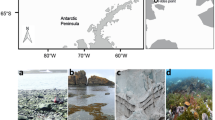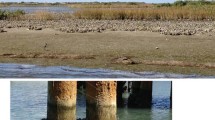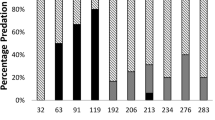Abstract
Management agencies are considering introducing the Suminoe oyster Crassostrea ariakensis into Chesapeake Bay, USA. It is unknown if the growth of feral populations of this non-native oyster would be regulated by the same predators that once controlled the abundance of the native eastern oyster C. virginica. In laboratory studies, we compared the relative susceptibility of juvenile diploids (shell height < 25 mm) of both oyster species to invertebrate predators of eastern oyster juveniles. Predators included four species of mud crabs [Rhithropanopeus harrisii (carapace width 7–11 mm), Eurypanopeus depressus (6–21 mm), Dyspanopeus sayi (8–20 mm), and Panopeus herbstii (9–29 mm)], the blue crab Callinectes sapidus (35–65 mm), and two sizes of polyclad flatworms (Stylochus ellipticus and possibly Euplana gracilis; planar area ≲5 mm2 and ∼14 to 88 mm2). All four species of mud crab and the blue crab preyed significantly (ANOVA, P ≤ 0.05) more on C. ariakensis than on C. virginica, but predation by flatworms of both sizes did not differ significantly between oyster species. The greater susceptibility of C. ariakensis to crab predation was likely due to its shell compression strength being 64% lower than that of C. virginica (P = 0.005). To test for predator-induced enhancement of shell strength, we held oysters of both species for 54 days in the presence of, but protected from, C. sapidus and R. harrisii. Crabs were fed congeneric oysters twice weekly within each aquarium. Compared to controls, shell strength of C. virginica exposed to R. harrisii increased significantly (P < 0.043), as did shell strength of both oyster species exposed to C. sapidus (P < 0.01). Despite the changes in shell strength by both oyster species in the presence of C. sapidus, the shell of C. ariakensis remained 57% weaker than C. virginica. We conclude that, because C. ariakensis exposed to predators continued to have a weaker shell relative to C. virginica, the natural suite of crab and flatworm predators in Chesapeake Bay will likely serve to control the abundance of feral C. ariakensis. We caution that the situation in the natural environment may be sufficiently different in some locations that C. ariakensis may be able to compensate for its greater vulnerability to crab predation and hence become a nuisance species.
Similar content being viewed by others
References
Abbe GR, Breitburg DL (1992) The influence of oyster toadfish (Opsanus tau) and crabs (Callinectes sapidus and Xanthidae) on survival of oyster (Crassostrea virginica) spat in Chesapeake Bay: does spat protection always work? Aquaculture 107:21–31
Allen SK (2005) Stalemate over the new oyster. Va Mar Res Bull 37:2–16
Allen SK, Downing SL (1986) Performance of triploid Pacific oysters, Crassostrea gigas (Thunberg). 1. Survival, growth, glycogen-content, and sexual maturation in yearlings. J Exp Mar Biol Ecol 102:197–208
Bishop MJ, Peterson CH (2006) When r-selection may not predict introduced-species proliferation: predation of a non-native oyster. Ecol Appl 16:718–730
Bisker R, Castagna M (1987) Predation on single spat oysters Crassostrea virginica (Gmelin) by blue crabs Callinectes sapidus Rathbun and mud crabs Panopeus herbstii Milne-Edwards. J Shellfish Res 6:37–40
Breese WP, Malouf RE (1977) Hatchery rearing techniques for the oyster Crassostrea rivularis Gould. Aquaculture 12:123–126
Carlton JT (1999) Molluscan invasions in marine and estuarine communities. Malacologia 41:439–454
Carlton JT, Thompson JK, Schemel LE, Nichols FH (1990) Remarkable invasion of San Francisco Bay (California, USA) by the Asian clam Potamacorbula amurensis. I. Introduction and dispersal. Mar Ecol Prog Ser 66:81–94
Carriker MR (1996) The shell and ligament. In: Kennedy VS, Newell RIE, Eble AF (eds) The eastern oyster, Crassostrea virginica. Maryland Sea Grant Publication, College Park, pp 75–168
Carter JG (1980) Environmental and biological controls of bivalve shell mineralogy and microstructure. In: Rhoads DC, Lutz RA (eds) Skeletal growth of aquatic organisms: biological records of environmental change. Plenum Press, New York, pp 69–113
Cheung SG, Lam S, Gao QF, Mak KK, Shin PKS (2004) Induced anti-predator responses of the green mussel, Perna viridis (L.), on exposure to the predatory gastropod, Thais clavigera Küster, and the swimming crab, Thalamita danae Stimpson. Mar Biol 144:675–684
Christensen DJ (1973) Prey preference of Stylochus ellipticus in Chesapeake Bay. Proc Natl Shellfish Assoc 63:35–38
Cloern JE (1982) Does the benthos control phytoplankton biomass in South San Francisco Bay? Mar Ecol Prog Ser 9:191–202
Eggleston DB (1990) Foraging behavior of the blue crab, Callinectes sapidus, on juvenile oysters, Crassostrea virginica: effects of prey density and size. Bull Mar Sci 46:62–82
Ford SE, Tripp MR (1996) Diseases and defense mechanisms. In: Kennedy VS, Newell RIE, Eble AF (eds) The eastern oyster, Crassostrea virginica. Maryland Sea Grant Publication, College Park, pp 581–660
Goulletquer P, Wolowicz M (1989) The shell of Cardium edule, Cardium glaucum and Ruditapes philippinarum: organic content, composition and energy value, as determined by different methods. J Mar Biol Assoc UK 69:563–572
Hare MP, Palumbi SR, Butman CA (2000) Single-step species identification of bivalve larvae using multiplex polymerase chain reaction. Mar Biol 137:953–961
Kennedy VS (1996) Biology of larvae and spat. In: Kennedy VS, Newell RIE, Eble AF (eds) The eastern oyster, Crassostrea virginica. Maryland Sea Grant Publication, College Park, pp 371–421
Kennedy VS, Breisch LL (1983) Sixteen decades of political management of the oyster fishery in Maryland’s Chesapeake Bay. J Environ Manage 16:153–171
Kimmerer WJ, Gartside E, Orsi JJ (1994) Predation by an introduced clam as the likely cause of substantial declines in zooplankton in San Francisco Bay. Mar Ecol Prog Ser 113:81–93
Krantz GE, Chamberlin JV (1978) Blue crab predation on cultchless oyster spat. Proc Natl Shellfish Assoc 68:38–41
Landers WS, Rhodes EW (1970) Some factors influencing predation by the flatworm, Stylochus ellipticus (Girard), on oysters. Chesapeake Sci 11:55–60
Lee T, Siripattrawan S, Ituarte CF, Ó Foighil D (2005) Invasion of the clonal clams: Corbicula lineages in the New World. Am Malacol Bull 20:113–122
Leonard GH, Bertness MD, Yund PO (1999) Crab predation, waterborne cues, and inducible defenses in the blue mussel, Mytilus edulis. Ecology 80:1–14
Loosanoff VL (1956) Two obscure oyster enemies in New England waters. Science 123:1119–1120
McDermott JJ, Flower FB (1953) Preliminary studies of the common mud crabs on oyster beds of Delaware Bay. Proc Natl Shellfish Assoc 1952:47–50
Milke LM, Kennedy VS (2001) Mud crabs (Xanthidae) in Chesapeake Bay: claw characteristics and predation on epifaunal bivalves. Invert Biol 120:67–77
Nalepa TF, Schloesser DW (1993) Zebra mussels. Biology, impacts, and control. Lewis Publishers, Boca Raton
Newell RIE, Alspach GS, Kennedy VS, Jacobs D (2000) Mortality of newly metamorphosed eastern oysters (Crassostrea virginica Gmelin) in mesohaline Chesapeake Bay. Mar Biol 136:665–676
Newell RIE, Fisher TR, Holyoke RR, Cornwell JC (2005) Influence of eastern oysters on nitrogen and phosphorus regeneration in Chesapeake Bay, USA. In: Dame R, Olenin S (eds) The comparative roles of suspension feeders in ecosystems, vol 47. NATO Science Series: IV—Earth and environmental sciences. Springer, Netherlands, pp 93–120
NRC (National Research Council) (2004) Nonnative oysters in the Chesapeake Bay. The National Academies Press, Washington, District of Columbia
Osman RW, Abbe GR (1994) Post-settlement factors affecting oyster recruitment in the Chesapeake Bay, USA. In: Dyer K, Orth RJ (eds) Changes in fluxes in estuaries: implications from science to management. Olsen and Olsen, Fredensborg, pp 335–340
Palmer AR (1981) Do carbonate skeletons limit the rate of body growth? Nature 292:150–152
Prezant RS, Chapman EJ, McDougall A (2006) In utero predator-induced responses in the viviparid snail Bellamya chinensis. Can J Zool 84:600–608
Price J, Thayer GW, LaCroix MW, Montgomery GP (1976) The organic content of shells and soft tissues of selected estuarine gastropods and pelecypods. Proc Natl Shellfish Assoc 65:26–31
Reimer O, Harms-Ringdahl S (2001) Predator-inducible changes in blue mussels from the predator-free Baltic Sea. Mar Biol 139:959–965
Ruther J, Meiners T, Steidle JLM (2002) Rich in phenomena—lacking in terms. A classification of kairomones. Chemoecology 12:161–167
Seed R, Hughes RN (1995) Criteria for prey size-selection in molluscivorous crabs with contrasting claw morphologies. J Exp Mar Biol Ecol 193:177–195
Seed R, Suchanek TH (1992) Population and community ecology of Mytilus. In: Gosling E (ed) The Mussel Mytilus: ecology, physiology, genetics and culture. Elsevier, Amsterdam, pp 87–169
Smith RJF (1992) Alarm signals in fishes. Rev Fish Biol Fish 2:33–63
Smith LD, Jennings JA (2000) Induced defensive responses by the bivalve Mytilus edulis to predators with different attack modes. Mar Biol 136:461–469
Sokal RR, Rohlf FJ (1995) Biometry, 3rd edn. WH Freeman, New York
Stabell OB, Ogbebo F, Primicerio R (2003) Inducible defences in Daphnia depend on latent alarm signals from conspecific prey activated in predators. Chem Senses 28:141–153
Strayer DL, Caraco NF, Cole JJ, Findlay S, Pace ML (1999) Transformation of freshwater ecosystems by bivalves. A case study of zebra mussels in the Hudson River. Bioscience 49:19–27
Taylor JD, Layman M (1972) The mechanical properties of bivalve (Mollusca) shell structures. Paleontology 15:73–87
Thompson TG, Chow TJ (1955) The strontium-calcium atom ratio in carbonate-secreting marine organisms. Deep Sea Res 3(suppl):20–39
Vermeij GJ (1987) Evolution and escalation: an ecological history of life. Princeton University Press, Princeton
Webster JR, Medford RZ (1961) Flatworm distribution and associated oyster mortality in Chesapeake Bay. Proc Natl Shellfish Assoc 50:89–95
White ME, Wilson EA (1996) Predators, pests, and competitors. In: Kennedy VS, Newell RIE, Eble AF (eds) The eastern oyster, Crassostrea virginica. Maryland Sea Grant Publication, College Park, pp 559–579
Zhou M, Allen SK (2003) A review of published work on Crassostrea ariakensis. J Shellfish Res 22:1–20
Zuschin M, Stanton RJ (2001) Experimental measurement of shell strength and its taphonomic interpretation. Palaios 16:161–170
Acknowledgments
We are grateful to Ed Jones (Taylor Shellfish) for providing Suminoe oyster larvae; Mark Luckenbach (Virginia Institute for Marine Science) for providing eastern oyster larvae; Melissa Radcliffe (Horn Point Laboratory) for supplying cultured microalgae; John Thiravong (University of Delaware Center for Composite Materials) for providing technical assistance with the Instron instrument; Matt Hare (University of Maryland College Park) for performing genetic analysis for oyster species identification; Angela Freeman for initial technical assistance; George Abbe, Don Boesch, and Robert Prezant and two anonymous reviewers for constructive comments. This research was supported by award NA16RG2207/07-5-28068J from Maryland Sea Grant, National Oceanic and Atmospheric Administration and award NA04NMF4570425 from NMFS-NOAA non-native oyster research program. The experiments reported herein comply with the current laws of the USA.
Author information
Authors and Affiliations
Corresponding author
Additional information
Communicated by R.J. Thompson.
Rights and permissions
About this article
Cite this article
Newell, R.I.E., Kennedy, V.S. & Shaw, K.S. Comparative vulnerability to predators, and induced defense responses, of eastern oysters Crassostrea virginica and non-native Crassostrea ariakensis oysters in Chesapeake Bay. Mar Biol 152, 449–460 (2007). https://doi.org/10.1007/s00227-007-0706-0
Received:
Accepted:
Published:
Issue Date:
DOI: https://doi.org/10.1007/s00227-007-0706-0




